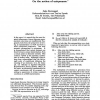Free Online Productivity Tools
i2Speak
i2Symbol
i2OCR
iTex2Img
iWeb2Print
iWeb2Shot
i2Type
iPdf2Split
iPdf2Merge
i2Bopomofo
i2Arabic
i2Style
i2Image
i2PDF
iLatex2Rtf
Sci2ools
87
Voted
EACL
1993
ACL Anthology
1993
ACL Anthology
On the notion of uniqueness
In the paper it is argued that for some linguistic phenomena, current discourse representation structures are insufficiently finegrained, both from the perspective of serving as representation in NLP and from a truth conditional perspective. One such semantic phenomenon is uniqueness. It is demonstrated that certain elements are forced to have a unique interpretation, from a certain point in discourse onwards. This could be viewed as the semantic counterpart of surface order. Although it has always been acknowledged that the left-toright order of constituents influences the meaning of an utterance, it is, for example, not reflected in standard Discourse Representation Theory ([Kamp, 1981]). In the paper, an alternative representation for unique constituents will be proposed, resulting in asymmetry of certain conjoined conditions in a DRS-representation.
Discourse Representation | Discourse Representation Structures | EACL 1993 | Natural Language Processing | Truth Conditional Perspective |
Related Content
| Added | 02 Nov 2010 |
| Updated | 02 Nov 2010 |
| Type | Conference |
| Year | 1993 |
| Where | EACL |
| Authors | Joke Dorrepaal |
Comments (0)

